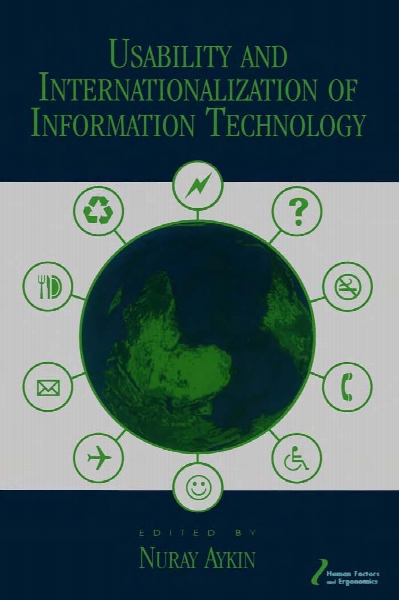Usability and internationalization of information technology
- نوع فایل : کتاب
- زبان : انگلیسی
- مؤلف : Nuray Aykin
- ناشر : Mahwah, NJ : Lawrence Erlbaum
- چاپ و سال / کشور: 2005
- شابک / ISBN : 9781410611093
Description
Series Foreword—Gavriel Salvendy xiii Foreword to Book—-Jakob Nielsen xv Preface xix PART 1: INTRODUCTION AND CULTURAL CONSIDERATIONS 1. Overview: Where to Start and What to Consider 3 Nuray Aykin 2. Practical Issues and Guidelines 21 for International Information Display Nuray Aykin, Allen E. Milewski 3. User Interface Design and Culture 51 Aaron Marcus 4. Synthesizing the Literature on Cultural Values 79 Emilie W. Gould 5. Managing Multicultural Content in the Global 123 Enterprise Jorden Woods v vi CONTENTS IN BRIEF PART 2: DESIGN ISSUES AND USABILITY ENGINEERING 6. Graphics: The Not Quite Universal Language 157 William Horton 7. "Sunday in Shanghai, Monday in Madrid?!": 189 Key Issues and Decisions in Planning International User Studies Susan M. Dray, David A. Siegel 8. Cost-Justifying Usability Engineering 213 for Cross-Cultural User Interface Design Deborah J. Mayhew, Randolph G. Bias PART 3: CASE STUDIES 9. Cross-Cultural Design for Children in a Cyber Setting 253 Jorian Clarke 10. Intercultural Human-Machine Systems: Empirical 277 Study of User Requirements in Mainland China Kerstin Rose 11. Travel Planning on the Web: A Cross-Cultural 313 Case Study Helmut Degen, Kem-Laurin Lubin, Sonja Pedell, Zheng Ji Appendix 345 Author Index 351 Subject Index 357 Contents Series Foreword—Gavriel Salvendy xiii Foreword to Book—Jakob Nielsen xv Preface xix PART 1: INTRODUCTION AND CULTURAL CONSIDERATIONS 1. Overview: Where to Start and What to Consider 3 Nuray Aykin How and where to start? 3 Why internationalization and localization? 4 Terminology 4 The Globalization process 5 Globalization teams: A need for change in the organization 7 Internationalization and localization team roles 8 Legal issues 15 Summary 19 References 19 2. Practical Issues and Guidelines 21 for International Information Display Nuray Aykin, Allen E. Milewski International information display 21 Graphics and icons 22 vn viii CONTENTS Language: Rendering and translating 23 Data object formatting 34 Color 46 Layout 49 Summary 49 References 49 3. User Interface Design and Culture 51 Aaron Marcus Introduction 51 Mapping dimensions to components 58 Future study of culture in relation to user interface design 64 Conclusions 67 Acknowledgments 68 References 68 4. Synthesizing the Literature on Cultural Values 79 Emilie W. Gould Introduction 79 The advantages of intercultural communication theories for HCI design 80 Edward T. Hall: Chronemics, proxemics, and context 83 Edward C. Stewart and Milton J. Bennett: Subjective and objective culture 86 John C. Condon and Fathi S. Yousef: Extending the value orientations approach 89 Geert Hofstede: The durability of the "Software of the Mind" 91 Harry C. Triandis: Adding culture to social psychology 95 William B. Gudykunst: Building a unified theory of communication 98 Fons Trompenaars: Culture hits the best-seller list 103 David Victor: Capturing intercultural communication in a mnemonic 111 Summary 114 Future directions 115 Conclusion 117 References 117 CONTENTS ix 5. Managing Multicultural Content in the Global 123 Enterprise Jorden Woods Introduction and the ideal enterprise 123 Challenges to successful globalization 127 Best practices 131 The details of implementing best practices 136 Workflow and process automation 146 Linguistic technologies 151 Translation service providers 153 Overview and conclusions 154 PART 2: DESIGN ISSUES AND USABILITY ENGINEERING 6. Graphics: The Not Quite Universal Language 157 William Horton Introduction 157 Why use graphics if they are not universal? 158 Select an approach 158 First, globalize 160 Second, localize 178 Summary 184 References 186 7. "Sunday in Shanghai, Monday in Madrid?!": 189 Key Issues and Decisions in Planning International User Studies Susan M. Dray, David A. Siegel Introduction 189 Selecting where to go 191 Arranging for research resources in-country 196 Modifying a recruiting strategy and screener to reflect local cultural issues 200 Preparing or adapting the protocol and/or test plan 204 Arranging for translation 206 Training local facilitators and preparing facilities 208 Multicountry studies: serial or parallel? 211 Conclusions 212 References 212 x CONTENTS 8. Cost-Justifying Usability Engineering 213 for Cross-Cultural User Interface Design Deborah J. Mayhew, Randolph G. Bias Introduction 213 Framework for cost justification 220 Sample cost-benefit analyses for cross-cultural usability engineering projects 223 Summary and conclusions 245 Acknowledgments 248 References 248 PART 3: CASE STUDIES 9. Cross-Cultural Design for Children in a Cyber Setting 253 Jorian Clarke Introduction 253 Positive indicators of children's usage of new media 255 Issues surrounding cyber design 259 Case Study: KidsCom.com development experiences 264 References 276 10. Intercultural Human-Machine Systems: Empirical 277 Study of User Requirements in Mainland China Kerstin Rose Introduction 277 Approach to intercultural human-machine system design 278 INTOPS-2: Intercultural human-machine system design for the Chinese market 282 Selected results of the investigation in China 292 Conclusions on human-machine system design for the Chinese market 307 Acknowledgments 310 References 310 11. Travel Planning on the Web: A Cross-Cultural 313 Case Study Helmut Degen, Kem-Laurin Lubin, Sonja Pedell, Ji Zheng Introduction 313 Applied methods 317 CONTENTS xi Results 320 Interpretation of cross-country results 336 Summary and conclusions 342 Acknowledgments 343 References 343 Appendix 345 Author Index 351 Subject Index 357


